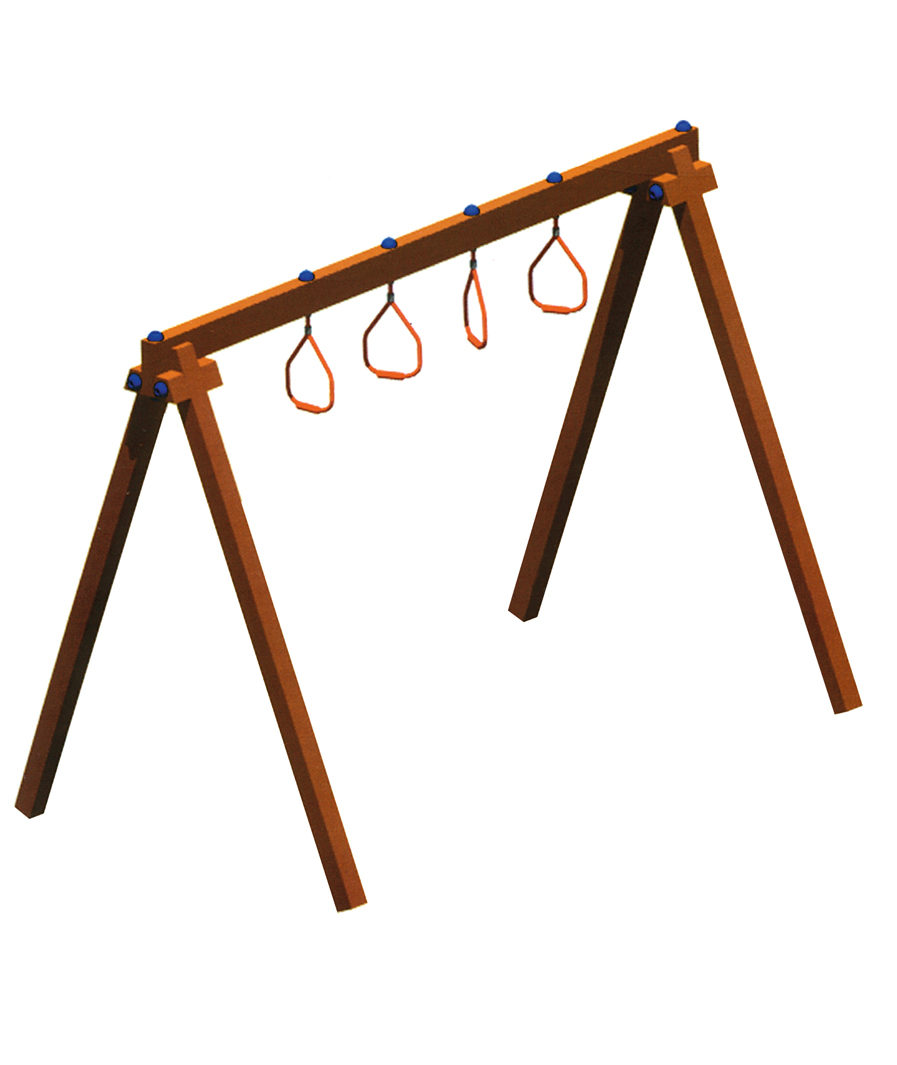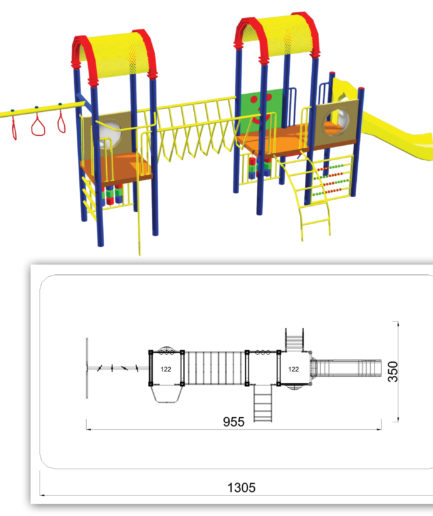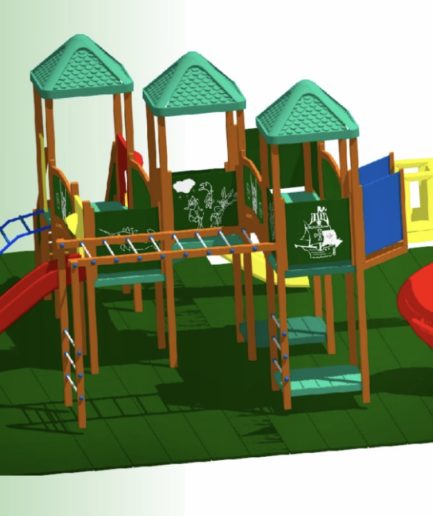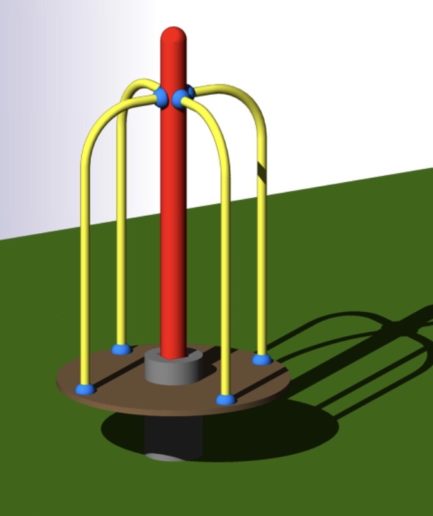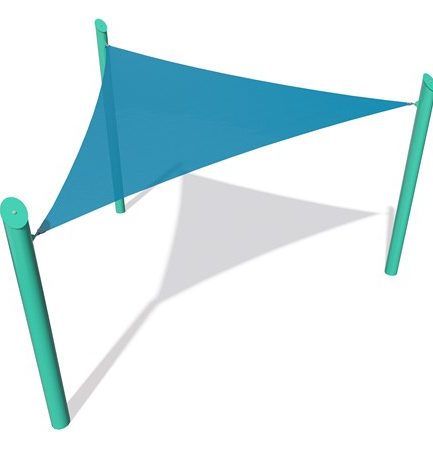CLIMBING FRAMES 0010-252
0010-252
The scale with handles is 300X170 cm and 219 cm high and consists of:
- 4 woods 9X9 cm and 220 cm high.
- 1 x 9x12x300 cm wood
- 4 trapezoidal cross sections 9X9 cm and base dimensions 34 cm and 27 cm.
- 5 handles made of 40cm polypropylene (PP) security wire rope 40mm (without screwing) with polypropylene (PP) F30X14 handle fixed length applied to the rope. It has a mechanically pressed metal safety ring with 3/8 inch F12 electro-galvanized bottom. The rope link is held by a mechanically pressed metal safety ring.
- 26 pcs polypropylene (PP) safety caps
- 4 pcs electro galvanized screws 15 mm x 25 cm.
- 6 pcs electro galvanized screws 15 mm x 23 cm.
- 8 pcs of 100 cm long galvanized hot-rolled laminates, 3 mm thick and 97 mm wide
- 4 pcs 15 mm x 120 mm electro-galvanized screws
- 4 pcs electro galvanized safety nuts M15.
This activity has an elongated “P” shape supported by two “L” shaped beams and on the instrument.
The horizontal beam of 300x9x12 cm has 5 handles with polypropylene (PP) handles at one end, supported by one end of two 220x9x9 cm “L” beams with their upper part below the horizontal beam. two trapezoidal woods 34 cm high and 27 cm high and 9X9 cm cross-section on the two sides of the inside and outside of the two “L” shaped beams with two electro-galvanized F15 mm x 25 cm screws with polypropylene plugs and at two points.
Trapezoidal woods are applied to the two “L” beams with two 15mm x 23cm screws and have polypropylene plugs at both ends.
The other end of the horizontal beam is applied to the vertical beam of the instrument with a 15 mm x 23 cm screw and has polypropylene safety plugs at both points.
The two vertical beams 220X9X9 cm bear the four lower end mounts of 100 mm 3 mm thickness of 97 mm and 97 mm width applied with a 15 mm x 120 mm electro-galvanized screw.
BACKPACK BASES
For fixing the instrument to the ground, each pair has a pair of mounting bases.
The mounting bases consist of two galvanized metal plates and then painted with electrostatic paint, of a shape “P” and approximately 100x12x4 cm thick and 0.5cm thick, which “embrace” the column and are joined by passing screws 5 / 8 ″ X15. At the bottom there is a metal flange to hold them in the concrete pit.
Only ground irons, which hold the column at least 5 cm above the ground, are prevented from being ground in order to prevent the wood from being eroded by soil moisture.
TIMBER
The wood used is composite non-stick Swedish pine timber, in accordance with EN 351. It is manufactured with special compound (welding of wood) in different sections depending on the intended use.
COMPOSITE wood is 40% stronger than whole wood. It has a strength of 360 kp / m2 and a specific weight of about 480 kg / m3.
- Contains about 15% moisture
- Contains minimal juices (resin) compared to other pine family trees in other countries (weather in northern Sweden up to -25 ° C)
- Has thermal conductivity s = 0.10 Kcal / Mho and sound insulation 3.5 times greater than concrete or brick of equal thickness.
- Has antimagnetic properties and is a poor conductor of electricity
- Resistant to fire and classified in categories F30 and F60 (by DIN 4120) according to its cross-section.
- When the outer part of the cross-section burns, its interior protects and retains its durability.
- It is processed just like commercial wood
- Maintains its shape and distorts or creates minimal fractures
- Annual wood rings are usually perpendicular to the long side of the cross-section with a significant increase in the mechanical strength of this surface when applied to floors.
All corners of the wood are planed with a radius of about 5 mm.
PLASTIC INFORMATION
The plastic components required to manufacture the equipment are highly resistant to UV radiation and adverse weather conditions. Preferred are recyclable materials such as polyethylene (PE) or polypropylene (PP). Specifically all screws protruding from the equipment over 5 mm are covered with polypropylene (PP) plastic plugs. They are also safe for the safety and health of children.
METALLIC ELEMENTS
The metallic elements used in the manufacture of the equipment (screws, joints, etc.) are made of metals either thermo-galvanized or electro-galvanized, where the surface preparation has been preceded by sandblasting or stainless steel. The dimensions and cross-sections of the metallic elements are sufficient to accommodate (with an appropriate safety factor) the loads for which they have been designed to withstand corrosion and adverse weather conditions.
PAINTS
The varnishes and the colors that protect the wooden parts are specially designed for the climate of our country (temperature changes, open or closed areas etc.) are absolutely harmless to the users (they do not contain lead, chromium, cadmium and other heavy metals). ) and give great durability to our constructions.
PACKING
The following procedure is used for fixing the equipment:
At this point where the column is to be placed, an 80 cm deep pit is opened. about 60cm in diameter. Then, once the column is inserted, the pit is filled with frusto-concreted concrete until it reaches 20 cm. from the surface of the ground, where it is covered with soil.
Only ground irons, which hold each column at a distance of about 10 cm from the ground, are prevented on the ground in order to prevent the wood from corroding the soil moisture.
All production work processes for the processing of raw materials are carried out according to:
- EN 1176 standards 1-6,
- ISO 9001: 2015 quality system
- The ISO 14001: 2015 environmental management system

